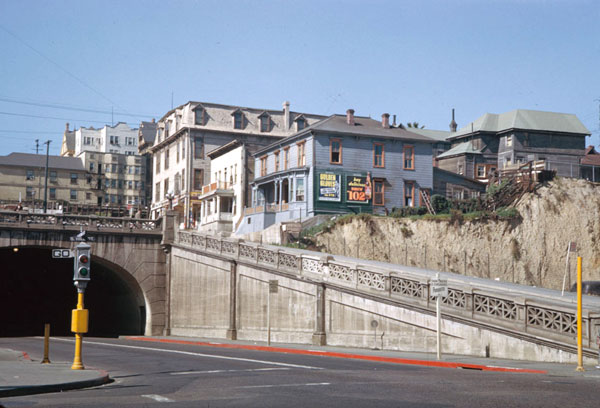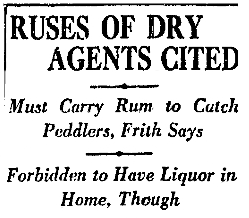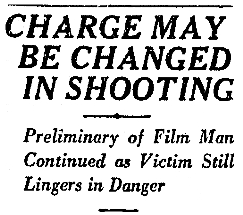On March 6, 2012, social historians, bloggers and tour guides Nathan Marsak and Richard Schave spoke to students in Dr. J.B.C. Axelrod’s History 395 course “Reading and Writing L.A.” at Occidental College about their work on the 1947project time travel blogs, including On Bunker Hill, and the many ways of telling the many stories of Los Angeles.
Category: nathan marsak
A LAVA Sunday Salon extra: Nathan Marsak on L.A. Noire
Day One: The Arrival

1947project plays LA Noire
Greetings, 47fans!
Been three years since our last post here, five-plus since those of the 1947 variety in particular. Of course post-47project there’s been On Bunker Hill and In SRO Land and many other adventures. But now it’s back to 1947–and why revisit that storied year of LA noir? LA Noire.
Unless you’ve been under a rock (a vaunted haunt, I’d say) you’ve likely heard of LA Noire. If not, here’s the skinny. Rockstar Games (renowned for their Grand Theft Auto franchise, say) and game developer Team Bondi announce in September ’06 that they intend to produce a video game set in the Los Angeles of 1947. Gamers drool over the prospective enormous open-world aspect and its MotionScan technology; we Old LA geeks get all excited about, of course, the prospect of shelving our Beta cassettes of The Turning Point and Hollow Triumph and taking a dérive through re-created 1947 LA. From there, we waited.
The years rolled on, drop dates came and went, but then, these things take time. Four years and change after that initial announcement, R*/Bondi announce Noire’s in-store buy-em-up day: May 17, 2011. In the swell of excitement and promotion before the game’s explosion onto the scene, the good folk of the gaming world go and call up those other mid-aught plumbers of the ’47geist: us.
In short, I’ve played it.
Last Saturday, Richard Schave, Kim Cooper and I were led from the Roosevelt Hotel’s sun-and-skin drenched poolside
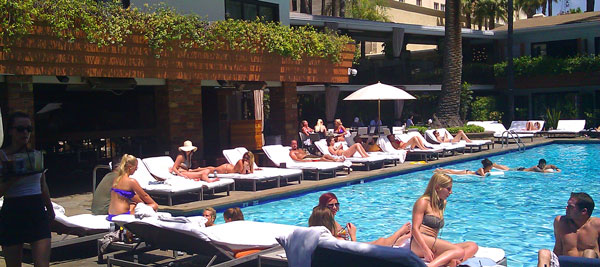
up into one of its dark, curtain-pulled rooms. Said room’s only salient feature? 60″ flat screen. Pleasantries are made all around and we get down to the business of playing LA Noire.
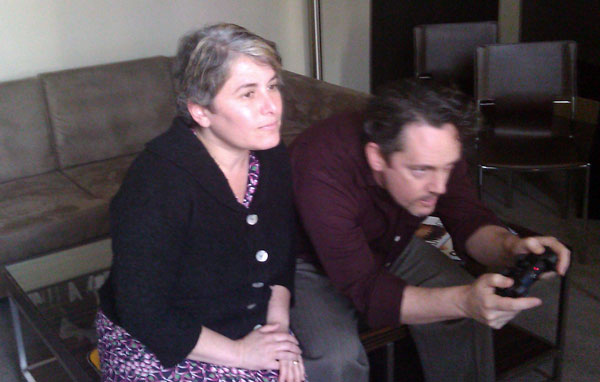
They had a lot of people there to play that day, in heavy rotation. Mostly gamers from fansites, whom I’m sure picked apart the roguelike procedural sandbox algorithms, about which I confess to know nothing. (Did play ToeJam & Earl in Panic on Funkotron all the way through in 1993 and said Ok, I’ve done that. Went boating once, too, and again, figured once was enough.) Kim’s no gamer either. So we abjured the gameplay and I therefore can comment neither on LA Noire’s authority as a “game” nor on how it succeeds in its mimetic vs. diegetic structure. I was there to look at stuff. Their company rep in our room gave us a half-hour (which we stretched into an hour) to tool around Old LA — an hour of incessant mumbles and rants that surely came off as so much demented logorrhea.
All of which I’ll share with you now. Will endeavor to imbue it with some measure of coherence one notch above logorrhea; can’t guarantee it won’t be demented.
First thing I did was study LAN‘s greater map. It’s an oblong affair, kind of a boomerang shape, roughly bordered by Franklin on the north, the river at the east, Olympic along the south, and La Brea at the west. Within these boundaries there are, I was told, eight miles of perfectly rendered roads to traverse. And I fully intended to put this topography to test in the limited time I had.
So we jumped into the world. Commenced inside Central Police Division, the 1896 “Old Central” at the SW corner of First and Hill (demolished in 1956, a year after Parker Center opened, natch). There was some ambient gametalk about how I was one Cole Phelps, former Marine and newly-minted LAPD detective, which was all fine and good when, as I ambled down some hallway, I glanced out of the side of my Phelpsian eye the view through the window and espied a great dusty promontory.
Oh, I knew it well all right. It loomed over First; the Hill Street Tunnel bored through it. That the game designers could get something that correct through some random dirty window, well, that bode well.
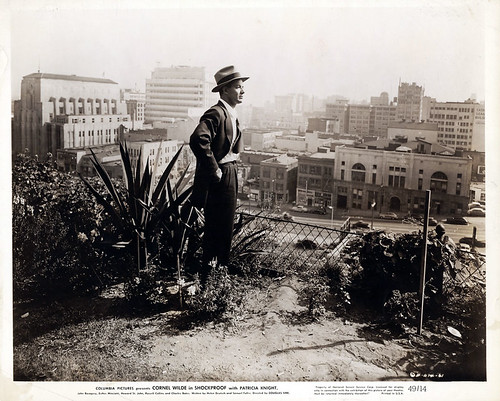
Above, aforementioned “dusty promontory” as seen from its dust down toward the police station of which I spake. Lobby card from Shockproof, 1949, author’s collection
That hill is long gone, and I wanted to see it: without a thought I roughly pushed past the odd dirty desk and water cooler, shoving aside my fellow officer until at once, after a lifetime of waiting, I bolted out into the daylight. The 1947 daylight. Blinked my eyes in wonder. A red car trolley clattered past. Turned and peered down First at Austin’s State Building looming in the distance. I’m not ashamed to say I found the moment absolutely thrilling.
Ran into the street, badged some broad in a shiny new Hudson, commandeered her car and set off for Bunker Hill, every synapse firing. Some semaphore dared raise its “stop” signal at me and I blew through the intersection, neatly clipping a Caddy, fishtailing onto the sidewalk, sending pedestrians scurrying. (All at once I could see the appeal of this thing.) But my car, and neurons, came to a screeching halt as I hit Second and Hill — for there, instead of roadbed running up to Olive, were only stairs alongside the tunnel.
Which was just…wrong. I gunned my Hudson up those steps anyway, made it about halfway before my transport chugged to a sad stop. Fine, I’d take in the Hill on foot. I ran up the rest of the staircase (without expending any actual energy or effort…doubling the appeal!) and turned to ask…where was the Astoria? This game’s early promise was dwindlling rapidly. The Hillcrest had a butcher instead of its dry cleaners? This was not boding well.
The most-used phrase to describe LA Noire is “perfectly recreated.” Now, let me say that I’m not trying to be needlessly critical, but this is criticism after all, and it’s the only kind of criticism I do. A post such as this merely underscores that we at 1947p take our re-presentation of a world dear to our hearts with unyielding gravity. To put it nicely, omission of oft-photographed (disinclude Angels Flight Pharmacy? Really?) buildings is a bit perplexing. That the repetition of perplexing omissions was disheartening and maddening I trust is a given.
I queried some of the game guys afterward about why some landmarks might be missing, and they posited that it could be because Corporate couldn’t secure the rights to images of those structures. A possibility, but not a probability. For example, back in Noire‘s LA, I cruised up Third to Grand. Looking north, at the NW corner, there stood 301/303 S Grand, AKA 725 W 3rd. Shots of this house are pretty rare. But across the street at the NE corner, there was no Nugent, nor, at the SE corner, was there the Lovejoy, which have both been captured to great degree. Thus it was with some trepidation I walked up to Bunker Hill Avenue — which wasn’t there. It had been reconfigured as an alleyway. Bunker Hill Avenue is unusually, unreasonably important to Los Angeles, mid-Century especially; noir pictures were shot there, for example, The Castle was used in Kiss Me Deadly. If they’d asked me for any or all of my many rights-free vintage postcards of the Melrose, or unpublished kodachromes of the Castle, they coulda had ’em. (Don’t even get me started on where they put the terminus of the Third Street tunnel.)
So I trudged back to town. At least I could ride Angels Flight down to Hill, right? Nope, in this world Angels Flight is stationary. I can plow a beautifully rendered Packard Deluxe Clipper 8 Club Sedan through three blocks of streetlights, but can’t ride the arguably most iconic piece of Angelenic transportation 315 feet? With streets replete with DeSotos and crisscrossing streetcars, 1947 the height of its ridership, Angels Flight sits as motionless as it did during its down days. This too I brought up to one of the reps, and was told that what I was playing wasn’t the final version, and that perhaps a running funicular was to be, but just, you know, not in this “build.” I believe what he was attempting to connote was that I was playing an old version. So there’s your caveat, dear reader: perhaps everything I’m saying is based on some outdated model. Perhaps everything I’m bitching about is being fixed right now.
Naturally my most stringent criticism was going to be reserved for Bunker Hill; ironically, it was Bunker Hill which let down the most.
Once I was back in Noire’s downtown, my spirits lifted a bit. “Go to the Westminster!” chimed Kim, and I hotfoot-ed it down to Fourth and Main, and damned if that didn’t restore the thrilling feeling I had at the start. I took in the pre-extruded metal facade at Cliftons (now being returned to its pre-1962 visage) and was tickled by the tiki torches blazing in the doorway of the beautifully rendered Clifton’s Pacific Seas on Olive. Ambled amongst the palms toward the famous fountain in Pershing Square. The Rosslyn Hotel had her twin blade signs, just as she should. Standing at Sixth and Fig with the Gates over my left shoulder and the Richfield looming up above me was…something. The JESUS SAVES neon signs were where they should be, living large behind the library, and the Engstrum…the Engstrum. There I stood in front of the Sunkist and Engstrum with the Edison at my right. It was quite a moment. (Added bonus for the novitiate: backs to the library, a pop-up allowed us to access historical information about said Goodhue structure. These pop-uppy whatnots, suggested but not demanded, occur at the usual suspects across the City.) As an oil man by trade, my reigning interest was in motoring down to the gas holders the other side of Union Station. Those behemoths made my heart skip a beat. From there I sauntered like a flâneur up Seventh — Dodd and Richards row, pretty nice.
But it was the Spring Arcade…that really showed me the true virtue of the game. I was busy crashing Chryslers, gazing gape-mouthed as I pummeled pedestrians, blah dee blah, video game stuff, when I screeeee parked my car lengthwise across Broadway. Exited said car, walked with dedicated purpose across the street — traffic came to a halt, ladies in veils waved their begloved fists at me — and I stepped into the quietude of the Spring Arcade. It was a revelation. Deep into our maniacal race to experience all we could see in this recreated world, I was now in the Arcade sans crap electronics and discount socks: a place of peace and elegance, as anathematic to 1947 as it is to 2011. People of 2011 (that’s you) can and should traverse what is LA’s most sublime space. That you may imagine its former glory, courtesy of and via this game, is rather lovely.
Would that it were all hearts and rainbows, though. There were problems:
The Westminster lacked its trademark sunburst canopies. And consider the San Carlos: in the Noire version of ’47 reality, the San Carlos exists, structurally, somewhere between its original “wedding cake” incarnation of 1911 and its 1930s cleanlining, i.e., there was an apparent misalignment in the matter transporter integrator/disentgrator device (shameless plug for the ’58 version of The Fly) because here the San Carlos retains its Auditorium-era finials, though in a mutated streamline version. Weird.
Also, the Hippodrome has been depicted as a structure separate from the Westminster. Across the street was of course The Follies, which has here been mistakenly represented as a motion-picture house, instead of as a burlesque-eteria: its bump-n-grind 1947 reality would have actually made this landscape more noir. (I might add that in Noire’s world LA’s picture-houses, according to their maquees, featured the same few 1947 noir films, and ignored the dictate of Warner’s showing Warners, RKO showing theirs, etc.)
Where was the Follies’ neighbor Goodfellow’s Grotto, touchstone of the time? And, to this day, along the backside of the Barclay, there exists a magnificent ghost sign, sad to see the gamefolk didn’t record it — the IN Van Nuys hotel had become the Barclay a full decade before 1947: so, where was the thing? It’s not like Team Bondi wasn’t there to photographic it: we all followed the tale of their rummaging through the hotel. The Chocolate Shop was an empty lot. The Baltimore Hotel was missing its blade signage (crimininally dumpstered a decade ago), but, most shockingly, King Eddie was utterly absent. (Which is absolutely mystifying in that it stands there to this day in all its glory. Perhaps it’s just not in this “build?”) The Monarch was also plucked from the landscape. Odd.
Some examples. Here‘s a screengrab from their site.

We’re looking up Fourth toward Olive. Now, while you’re playing the game, you’re very likely concerned with that guy shooting at you. But here, we treat background as foreground, so: the designers used an early image on which to render this scene. By 1947, the Hotel Clark Garage, right, had become the Center Garage. That mission-style building, background left, the Fremont Hotel, had a blade sign running down its east flank.
Now here’s an instance where the designers used an image later than 1947 to design Noire:

We’re careening up Fig, and in the distance, the Architects Building, but see those letters atop? They read “Douglas Oil” and weren’t placed there until after Douglas purchased the building in 1959. Guess you should probably be more worried about the big scary car crashing into you, and all the flying sparks, but, well, we each have our own issues.
Again, there may be some bugs to be worked out. How was it that on my way up Main, St. Vibiana’s was missing, but turn around and head south, and it appears? The same wonkiness held true with a trip down Fig, wherein the Architects Building is an empty lot; but, motor a couple blocks and crane your head around, there it is behind you. Perhaps these li’l bugaboos (I’m sure they just rasterized their RAM with too little ROM, or something) will’ve been worked out by the time they ship product. I hope so — these bits of motorized strangeness disorient and dislodge one from the moment.
You’d think we were done for the day, but KC & I, feverishly sweating blood, handing the controller to one another, and scaring our handler with the aforementioned glossolalia, had places to go. We tore down Wilshire — as much as I love the 60s Corporate Brutalism of DMJM’s American Cement, its absence certainly put me squarely in the game’s frame. But even with the Gaylord in the distance, Wilshire petered out before we hit The Ambassador. Yes, our first instance where we had come to The End of Our World. I don’t play games; I drive around LA. So I don’t take roadblocks lightly. But I was at the mercy of a higher power. Not the AA kind. The Thirteenth Floor kind.
So as I so often do (especially when confronted with a higher power), I went another way. Up Kenmore, or Arlington (another problem with this game — no street signs, not a one — should you want to know where you are, you have to jump out of gameplay and into a map) and into Hollywoodland. I could give just as detailed a description of Hollywood as I did for downtown (to which I did a disservice by not seeing a tenth of what I intended to) but I’ll save that, I think. Something tells me this won’t be the last of this nitpickery. Suffice it to say, for the time being, seeing Sardi’s in the flesh, so to speak, was charming. That I went to bed that night replaying how I clipped a Chrysler Airflow and slammed my midnight blue ’47 Lincoln Continental convertible into the NBC building…priceless. On the other hand, one of my mussitations while motoring along Sunset was “If the globe on Crossroads is spinning the right way, I’ll buy this thing.” Not only not the right way, but not spinning. At all. Like Angels Flight, it was stationary. And did I mention it wasn’t a globe? Just a blue ball.
How apt.
And thusly we were done. I tossed the controller to the floor and breathed a bit.
Ushered back out poolside, where all was well-lit, well-oiled and eumorphous. I wanted to cry, Don’t you know where you are? But I guess what I really meant was Don’t you know where I’ve been? Richard drove us back to Lincoln Heights. I was in an impatient state of anxiety over his unwillingness to blow through intersections and use sidewalks as his motorway.
As we drove home, the streets were uncrowded, the sky was sunny. Just as it was in…LA Noire. Which raises the question — what? Los Angeles was famously congested in 1947. Moreover, 1947 LA was poisonously polluted. My synapses sprang back to life, whence came new questions: having only traversed the Noire landscape in daylight, what does nighttime look like? (Are the animated signs animated, e.g., the bowling neon on Vine or the bowling incandescent on Sunset? Do vespertine activities shift in form and function?) Is the Noire world racially accurate? (As I drive down Central to bop with the heads, how do the demographics shift? Or up Broadway into New Chinatown? If faces are actually Asian there, will they differentiate in any way from those in our ShÅ-tÅkyÅ?)
We wound through the streets. I closed my eyes and tried to keep close to 1947 LA. Traffic roared by, but it didn’t sound quite correct. I mean, a Pontiac Streamliner 8 sounds like nothing else in the world. So my final muttering of the day was vedremo. Vedremo. Those Germans, they may have a word for everything, but the Italians, they only have words for those things that absolutely matter. A favorite of theirs, heard across pre-unification “Italy,” was/is vedremo. It means we shall see. We shall see, indeed.
But I live now. It’s been a couple days and I’ve cogitated a spell. If you’ve read this far, it won’t shock you to hear that I don’t cotton to anachronism. But Mr. Nathan, I hear you say, Renaissance art was the rebirth of antiquity, but you nevertheless routinely witness The Virgin in 15th c. Italian dress and the Four Fathers in Flemmish garb all the time. I would counter that the renovatio was about the remaking of a living culture through the interjection of Greco-Roman concepts of perfection, and if you want to continue your argument, I know, town clocks didn’t strike in the ancient Rome of Shakespeare’s Julius Ceasar either. Anachronism in the commission of art, is not only nothing new, but is common currency.
But I’m not writing about those. I’m writing about this. It purports to be historical, and when that happens, I’m on the case. I’m Cole-Fucking-Phelps.
Thus I am a detective, present day, but with retrocognitive disorder. Retrocognition is the concept that one can view a place and see into it its variegated layers of the past. While I may appear flippant on the subject, trust me, it’s a difficult state of perception to harbor or describe. The German critic Walter Benjamin described the colportage phenomenon of space, wherein “we simultaneously perceive all the events which might conceivably have taken place here.” But I don’t see Los Angeles, historically, as collapsed space; I see it as an artichoke, where one must peel back layers to reveal its heart. But it’s also an onion. Peel away its layers, find nothing inside, end up crying.
Neither 1947 Los Angeles nor its progeny LA Noire merely exist within the colportage; this game is being entered into the historiography of postwar Los Angeles. That canon is unbearably important (you know, to some of us), but who are its keepers? From March 2005 on, there was us at 47p. As has been discussed on this site, Ask the Dust didn’t look quite right, and DePalma’s 1947-fest Black Dahlia, released the year LA Noire was announced, shot as it was in Bulgaria, didn’t look quite right either. Those two movies were of course seen by a sum total of eleven people. Of HBO’s recent Mildred Pierce — tossing in a handful of palm trees and some awkward CGI couldn’t change the quality of that New York light. MP was seen by about a million people. Rockstar’s most recent venture, Grand Theft Auto IV, has sold twenty million units.
Noire shall then be the introduction for many to the wonderful world of 1947 Los Angeles, and as they learn it in its eidetic state, they are going to come away with a view of the City at a place in time that is almost, but not quite. If they learn it here first, then, when they subsequently see it presented accurately, they’ll figure the simulacrum to be the true version. (If this paragraph incites just one discussion about teleology and metanarrative, that would be awesome. If it makes you think about the Bath Block, that would be better.)
Coleridge was all up in our grill about willingly suspending disbelief. As such, I’d like to think the onus was solely on me, infinitely forgiving the game designers, and overlooking the limitations of the media — but I can’t. I understand that when I watch Life On Mars, set in the 70s, it’s low budget; they can’t remove every incorrect park bench and satellite antenna. That the Coens couldn’t expunge some modern Carl’s Jr. signage from their set-in-1980 No Country for Old Men, well, fine…their budget was a mere twenty-five million dollars. But LA Noire is total fantasy, drawn (literally) (no, not literally, because they “capture” these things, but anyway) from images, and its budget is fifty, maybe a hundred million dollars. So forgive me should I seem to hold these gents to unreasonably high standards. In layman’s terms, I’m not sayin’, I’m just sayin’: the past has as its nature an irretrievability and should someone attempt to articulate it, they are opening themselves up to rearticulation.
To wit: I think there’s a certain Whiggishness at work here, and rightfully so. LA of Noire is portrayed in all the glory of its expanse, after all, 1940s LA affluence and vastness took countless untolds out of the slums of the East. Its portrayal here is at the same time a revisionist history, in that LA’s skies are rendered blue and her streets rasterized as nearly empty. I have not, of course, touched on the whole “1947 LA is thick with serial killers and corruption” history, because I did not technically play the game. From perusing the R* site, seems like they’ve an angle as regards the Jeanne French killing. As “crime buff” falls under the umbrella of social historian, I have come to know, and from there have become close to, Jeanne French. Not Ellroy/Short close, but, still, don’t like to see her memory played with. The women for whom I have a particular affinity — Trelstad and Mondragon and of course my comrade Evelyn Winters — how, if at all, will they be fictionalized in this game?
Obviously, I want the world of 1947 treated with some respect. Noire’s designers did a commendable job, and were not lazy in attempting to achieve great things. But let me have a parting shot at this “perfectly recreated” business — the pundits routinely repeat it. I expect lazy journalism. But let’s say 1947 LA was perfectly recreated. By whom? Obviously not by someone with phenomenological understanding of the time and place (though such folk do exist, they are now really rather unreliable, God bless ’em) so it must therefore be done by historians…many of whom I know, none I which were ever contacted. Personally, I’ve never been to the past, nor have the game’s designers or builders, or scripters. Therefore LA Noire has an enormous burden to bear regarding its legacy — and if they’d worked on it another five years, would they reach a level of accuracy that would be acceptable to me? Even if I gave it an A-1 rating, wouldn’t some upstart still pick it apart?
Noire, I’m assuming, will be an international success. The upside being it will introduce the public to a world they may have never considered: e.g., one without computers and cell phones. Will players perceive this as a pro or con? How and why might they reinterpret their present via time spent in the past? We may romanticize the past, but nothing’s sugar-coated in noir. Murder is one thing; it’s eternal. 1947’s specific relationship to race and gender and class is something else altogether, and what players take away from living in that world, for however short a spell, will be telling. Heck, would it be cooler to play the game wth a case of typhoid or TB? One can only hope the millions who navigate this new (old) world take from it something useful and interesting. (Maybe they’ll even go and investigate some old noir thereby freeing up a seat for a good movie.)
But here’s the thing. I teach people the past. And now, along comes the best flight simulator I’ve ever seen. So is it better that LA Noire exists in its imperfect form than to not exist at all? I suppose so, since, as a young man it was beat into me that the cacotechny was part of the flux of art. And yet one can argue that producing something this good, this complex, with such problems, should not have been done. It raises too many philosophical issues, none of which I’m prepared to discuss, and likewise too many architectural issues, all of which I’m hot to discuss.
Which, unfortunately for both of us, dear reader, I will now have to do. As in, I just totally Amazon’d a PS3 (whatever that may be) and a 60″ flatscreen, just like they had in that there Roosevelt hotel room. And I have the sneaking suspicion that I’m going to spend the majority of these forthcoming lovely spring days, when a boy’s heart turns to romance, holed up in my TV room, shooting people in the face and driving an Olds up those Second Street stairs, whether they existed in real life or not.
It begins.
__
Reserve to take Nathan Marsak’s free downtown L.A. Noire walking tour on May 29. Details here.
In the Line of Duty
March 16, 1927
Los Angeles
 If the drys are gonna catch the wets, they’re gonna have to wet themselves. So to speak.
If the drys are gonna catch the wets, they’re gonna have to wet themselves. So to speak.
At the trial of John H. Wyncoop, former chief field agent for the boys of the California/Arizona Federal Prohibition Enforcement Department, Wyncoop said “I knew that if I had liquor in my possession I could more easily get bootleggers to believe that I was handling booze and therefore make it easier to arrest bootleggers.â€
Uh-huh.
Wyncoop is on trial because he turned twenty-nine bottles of liquor to his own use, instead of turning it into the government warehouse. Can’t those government know-nothings see that you need that hooch to go under deep cover? That he only took home that demon rum in the solemn performance of his duty?
(Convicted by a jury of illegal conversion, he was given a short term in the county jail.)
Behind Every Great Man…

March 16, 1927
Los Angeles
Clarence and Ona Brown were married in 1922, but now Ona wants a divorce. “When I married him,†said Mrs. Brown, while weeping bitterly during her testimony before Judge Summerfield, “he was a second-rate assistant director, and I made a director out of him. That cost me my home, for he got to thinking so well of himself he attempted to boss the house. He went nearly a year without even speaking to me.â€
(She may have a point; see this page under "salary.")
Ona’s testimony was neither denied nor contested, and she won her decree.
Think of that the next time you watch "Garbo’s favorite director".
Grossery Shopping
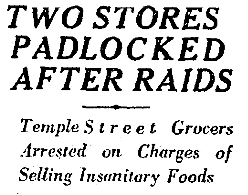
March 15, 1927
Los Angeles
Traditionally, the term greengrocer refers to a retail tradesperson who sells fresh fruits and vegetables. Should you be down on Temple Street, you might find grocer Edith Green to be a greengrocer of the green meat variety. Mmmm. Heck, even her Temple Street neighbor Abraham Margolis purveys criminally suspect comestibles.
Edith, at 922 Temple, and Abraham, at 937, were both charged with selling adulterated and contaminated foodstuffs. Stock amounting to $2,500 ($29,055 currentUSD) were ordered destroyed, she given thirty and he 180 days in the hoosegow, suspended on the condition that they clean up their act. And their stores.
As much fun as it would be to venture in to those structures now to see what eighty year-old smells lingered from the putrid pigs feet and bad borscht, we’ll have to content ourselves with visualizing such while whizzing under the one-ten:
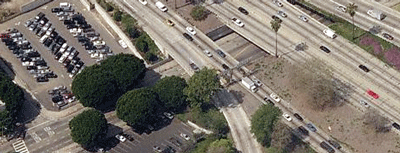
The Dyak Go Green
March 9, 1927
Borneo

On the one hand, the Dutch government’s Eurocentric cultural imperialism is wiping out the native culture of Borneo; on the other, they’re teaching headhunters the benefits of recycling.
The Dyak have long needed a nice fresh human caput for any and every sort of local ritual, but the generations-long war against the practice by their clogphilic, decapitated-headphobic overlords, has shown them the benefits of conservation (long practiced in the densely populated liberal parliamentary democracy that is Holland).
It is reported that now, the Dyak just borrow heads from neighbors for celebrations such as the birth of a child or the ending of a period of mourning. In fact, a paltry few heads are passed around in a tribe where just a generation ago each family had a bag of its own.
(According to Dr. William O. Krohn, Chicago alienist, there’s still no lack of headhunting when absolutely necessary-a rajah’s death demands craniums, for example, and victims thus beheaded are regarded as members of the monarch’s heavenly retinue.)
Despite the Dyak’s newfound respect for Westernized ideals, Borneo’s 1957 independence from windmills and tulips removed such colonialist standards of civility. The wild and wooly Americas, though, never had a break from her fascination with beheading.
Closer to home, LAPD became head-hunters of another kind when in January 1939, Cleveland Chief of Police George Matowitz received a letter postmarked from Los Angeles that read in part:

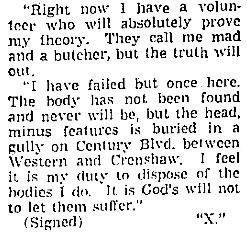
(Relatedly, while there are few great films about Los Angeles, there are fewer great films about headhunting. And Los Angeles.)
Of Pachydermatae and Murder
 March 2, 1927
March 2, 1927
Los Angeles
The Wonderly shooting of Emerson over an elephant’s affection has been continued until March 15th.
George “Scotty†Wonderly is the keeper of the bloodhounds for the studios, George Emerson, trainer of the lions at Universal City.
The story has a Old West theme to it to boot: on 15 February last, the two were arguing over the affections of said elephant at Universal. Wonderly called Emerson out; Wonderly strapped on his single shot .45 and there, on a rain-soaked muddy street, surrounded by wooden shacks and gambling dens and dance halls, Emerson staggered and twisted and slowly fell, a bullet through his breast, out his back, and lodged into the Last Chance Saloon. Elephants and the Old West, together again.
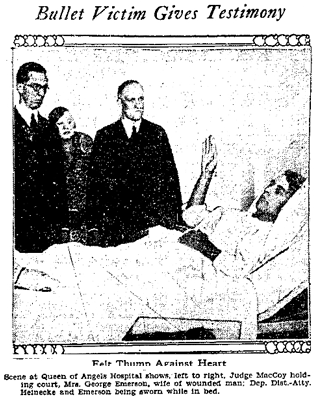
Here, Wonderly shows how his beloved raised its trunk…and went on to maintain that he acted in self-defense.
And of the love that dare not trumpet its name…the true heart’s desire of the elephant remains a sweet mystery.
The Great Phallusy
March 1, 1927
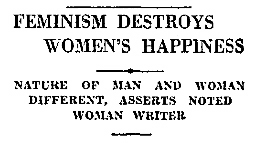 “Feminism is destructive of women’s happiness,†declares Gina Lombroso Ferrero, Italy’s first woman physician and daughter of Cesare Lombroso (who, with Gina’s husband, wrote The Female Offender). You may know Gina as author of the Italian 1922 antifeminist classic The Soul of Woman.
“Feminism is destructive of women’s happiness,†declares Gina Lombroso Ferrero, Italy’s first woman physician and daughter of Cesare Lombroso (who, with Gina’s husband, wrote The Female Offender). You may know Gina as author of the Italian 1922 antifeminist classic The Soul of Woman.
“It endeavors to bring women to the enjoyment of all privileges enjoyed by man; it encourages woman to copy man in the understanding that in this way woman will enjoy all pleasures which she formerly enjoyed as well as those which only man enjoys.
"Woman and man are different,†states the plucky Gina, "and suffer and derive pleasure from different things. Aspirations which are in the one case strong and permanent are in the other case minor and transitory. The aspirations toward glory, independence, riches, power are permanent and powerful in man, incremental and impermanent in woman, whereas aspiration to love and of loving, or reuniting one’s self to continuous life are stable elements in woman and comparatively passing and irrational impulses in man.†Therefore, woman can never fine happiness in doing man’s work, because it is too alien to her real interests.
Ya see, "once the man has ceased to love the woman from the viewpoint of the usefulness she can have for him, her altruism, her gentleness, her devotion to him, then he ceases to desire woman because of gratitude for the services she can render him, casts her aside as a permanent companion and sees in her only the female who can excite and satisfy his senses.â€
She may sound terrifically reactionary, but take solace in knowing that Mussolini exiled her in 1930 for being antifascist. Although to be honest, she was only exiled for being terrifically reactionary; GLF was also a staunch and vocal opponent of the wonders of the machine age.


